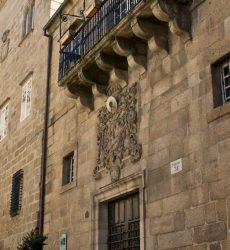
St. James’ Church
This 13th-century Romanesque church, in the village of Gustei, stands out for keeping its original belfry practically intact.
St. James’ church in Gustei, from the 13th century, stands out for keeping its original belfry, which is unusual. The belfry is arranged in two bays and; on it, there is a seated figure that may represent the titular saint, St. James.
The church ‘s main façade also preserves its Romanesque spirit, including a gate with semicircular arches and three archivolts. The first two archivolts have vegetal decoration, while the inner one combines vegetal decoration with figurative motifs: at the starts on both sides two images remind us of the Annunciation. There are three columns with vegetal-themed capitals, except one with a monstrous head. On the reworked tympanum, its lobed arch is still visible, clearly influenced by Ourense’s Cathedral. The text “THIS CHURCH IS A HOLY REFUGE” appears on it. The decoration of the façade is completed with diamond points.
The southern façade has a gate with a semicircular arch with vegetal capitals and a coat of arms on the tympanum. One of the corbels features a bearded male head. The cornice is supported by corbels decorated with a vegetal motifs, but some of them include human heads and geometric carvings. The northern façade, on the other hand, is simpler and concentrates the ornament on the corbels of the cornice, with geometric shapes.
The apse, rectangular in shape, concentrates its decoration on the corbels (whose motifs are geometric, vegetal and monstrous head) and on the vegetal capitals. As usual, crowning the back, an Agnus Dei with a ram carrying a cross on its back.
The interior, with a single nave and rectangular apse, preserves a triumphal arch which is supported by vegetal capitals. In the Baroque altarpiece, a polychrome stone statue of seated Apostle St. James, reminiscent of the one at Ourense’s cathedral.
A tour to follow the trail of this purely medieval style in the city. The walk begins at St. Martin’s Cathedral and continues exploring the still unknown rural Ourense.

